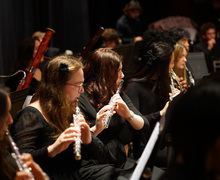SU launches second round of facade improvement program
Luke Rafferty | Asst. Photo Editor
The spire of St. Paul's Episcopal Cathedral will be illuminated as part of the first round of facade improvements to the Connective Corridor. SU recently launched the second round of the improvement program after receiving a $250,000 grant from the Central New York Regional Economic Development Council.
The streets along the Connective Corridor might be a bit brighter in the coming months thanks to renovations.
The improvements are part of the Connective Corridor Facade Improvement Program, which aims to update the outdoor appeal of many businesses on Syracuse University’s campus and in the downtown Syracuse area to attract investors and developers, according to an April 15 SU News release.
SU is now launching the second round of this program after it received a $250,000 grant from the Central New York Regional Economic Development Council, according to the release.
Applications for funding are just coming in now, and a committee will begin to review them in May, said Linda Dickerson Hartsock, director of the Connective Corridor project within SU’s Office of Community Engagement and Economic Development.
Allocations are made until the funding is expended, which ensures projects that are ready to start now have a higher chance of being funded, she said.
“This new round of grants gives even more businesses and organizations a chance to enhance the corridor brand and strengthen the signal that the Connective Corridor is an engaging place to be,” Chancellor Nancy Cantor said in the release.
A majority of the projects during phase one were completed in 2012, according to the release.
For the first round, SU received 60 applications, 40 of which received funding ranging from $5,000-$25,000 depending on the project, Hartsock said.
Projects benefiting from the first round of funding included new exterior doors along Jefferson Street for the Dey’s building, which will allow Gannon’s Isle Ice Cream to move into the building, she said.
Other projects included adding canopy awnings along the streets in Armory Square to make a common aesthetic and protect the streets from heavy rain or snow; painting and refinishing original buildings located along the Connective Corridor and adding public art similar to the mural on the side of the M. Lemp building, Hartsock said.
The M. Lemp building mural was designed and created by students and faculty within SU’s School of Architecture, she said. The mural contains QR codes, and when scanned with a smartphone, the mural shows a scene of the Erie Canal, Hartsock said.
Hartsock said she hopes new architectural lighting, also made possible through round one funding, will promote nighttime outdoor activity, especially in the winters.
The applications for the second round of funding are just as diverse as the projects within round one, she said.
“We look forward to see what projects are being proposed,” she said. “We’ve already heard from close to 20 property owners who have expressed interest.”
The main goal of the program is to increase downtown activity for people, businesses and investors, Hartsock said.
“This facade program not only gives the corridor visual identity, but it also helps catalyze investments by property owners to make their buildings more usable for retail, professional offices and attractive new downtown living options,” she said.
The second round of funding will be highly competitive, as larger projects that could have significant effects on the community will be proposed, Hartsock said.
“It makes it a corridor of people living, working and investing downtown,” she said. “And that’s really the larger vision.”
Published on April 23, 2013 at 11:52 pm
Contact Jen: jbundy@syr.edu





